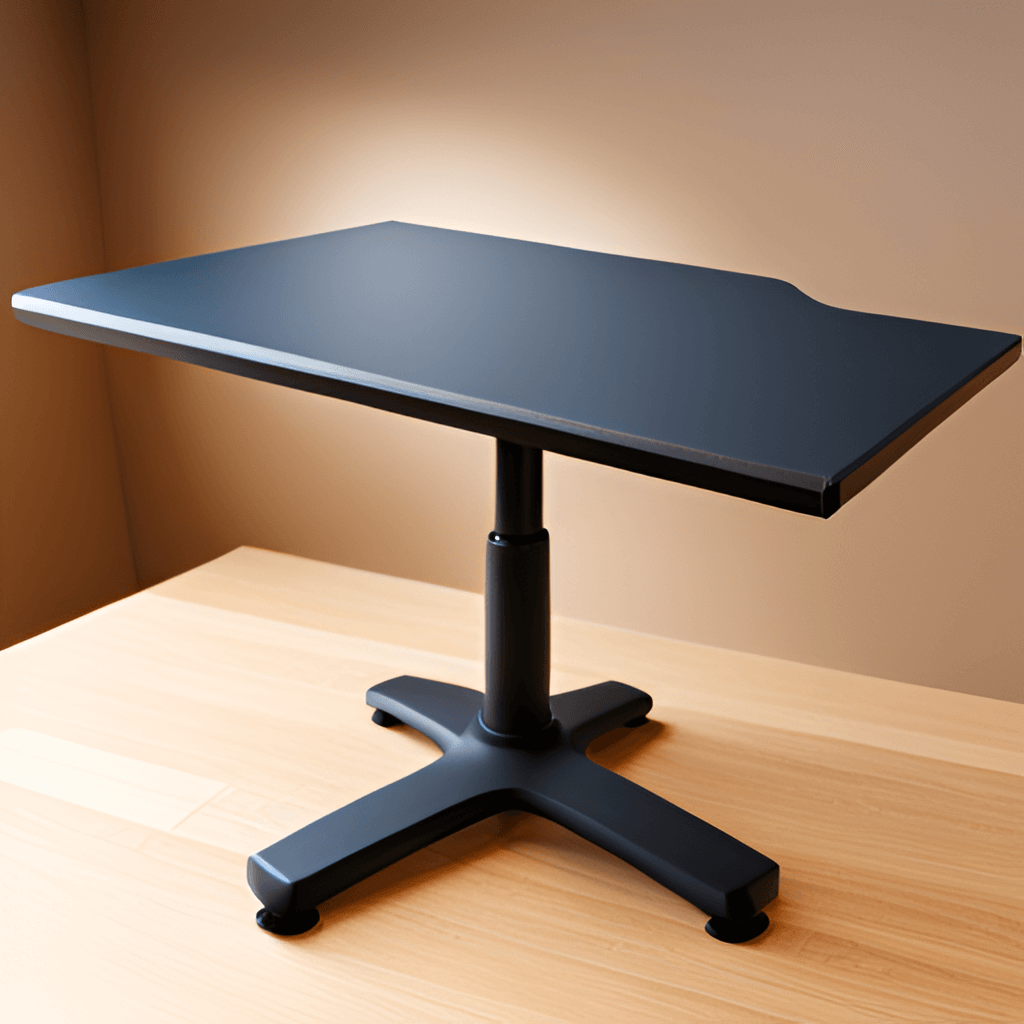
DIY Standing Desk Adjustable Solutions: Build Your Own Custom Workspace
In today’s fast-paced world, many of us find ourselves spending prolonged hours at our desks. Whether you work from home or in an office, the sedentary nature of desk work can take a toll on your health and productivity. That’s where DIY Standing Desk Adjustable Solutions come into play. In this article, we will explore the world of DIY standing desk solutions, offering you the opportunity to build your own custom workspace that fits your needs perfectly.
| Terms/Topics | Key Information Covered |
|---|---|
| Benefits of Standing Desks | – Improved posture and comfort – Increased energy and productivity – Potential health benefits |
| Identifying Your Needs | – Assessing workspace requirements – Ergonomic considerations – Customization options |
| Materials and Tools | – Essential materials and tools – Where to obtain them |
| DIY Standing Desk Solutions | – Basic DIY Standing Desk – Adjustable DIY Standing Desk – Repurposed Furniture Standing Desk – DIY Desk Converters |
| Ergonomic Accessories | – Recommended ergonomic accessories for comfort and productivity |
| Maintenance and Care | – Guidelines for maintaining and caring for your DIY standing desk – Surface protection |
| FAQ | – Answers to common questions about DIY standing desks and related topics |
| Cable Management and Organization | – Tips for managing cables effectively – Cable management products |
The Benefits of Standing Desks
Before diving into the practical aspects of building a DIY Standing Desk Adjustable Solution, let’s briefly discuss why standing desks are gaining popularity and why you might consider using one.
Improved Posture and Comfort
One of the primary benefits of using a standing desk is the improvement it can bring to your posture. By standing while you work, you are more likely to maintain a neutral spine position, reducing the risk of back pain and discomfort associated with prolonged sitting.
Increased Energy and Productivity
Many users report increased energy levels and productivity when using DIY Standing Desk Adjustable Solutions. Standing encourages better blood circulation, which can help you stay more alert and focused throughout the day.
Potential Health Benefits
Research suggests that standing desks may have several health benefits, including reduced risk of obesity, heart disease, and diabetes. While standing alone is not a magic solution, it can be a step in the right direction toward a healthier lifestyle.
For those seeking a more dynamic and health driven setup, treadmill desks have become an increasingly popular choice you can add to your project!
Identifying Your Needs
The first step in building your DIY Standing Desk Adjustable Solution is to identify your specific needs and preferences. Here are some key considerations:

Workspace Requirements
Consider the tasks you perform at your desk. Do you need ample space for multiple monitors, a laptop, or other equipment? Make a list of everything you plan to have on your desk to ensure it accommodates your workflow.
Ergonomics
Ergonomics is crucial to prevent discomfort or injury. Determine the correct desk height by measuring from your elbows to the floor while standing with your arms relaxed. Your DIY Standing Desk Adjustable Solution should allow for this height adjustment.
Customization
One of the beauties of a DIY Standing Desk Adjustable Solution is the ability to customize it according to your taste. Think about the materials and design that will complement your workspace and personal style. For more details on different desk types, including electric versus manual adjustments, check out our article on the types of standing desks.
Materials and Tools
Now that you have a clear idea of your workspace requirements and preferences, it’s time to gather the materials and tools needed to bring your DIY Standing Desk Adjustable Solution to life.
Materials
- Tabletop: Choose a sturdy and spacious tabletop. Options include solid wood, plywood, or even repurposed materials.
- Legs: You’ll need legs or a frame to support the tabletop. Consider adjustable legs for added versatility.
- Screws and Fasteners: Ensure you have the right screws and fasteners for securing the tabletop and legs.
- Finishing Materials: Depending on your chosen tabletop material, you might need paint, varnish, or a finish to protect and enhance its appearance.
Tools
- Power Drill: A power drill will be your best friend during assembly.
- Saw: If you need to cut or resize your tabletop or legs, a saw is essential.
- Screwdriver: For tightening screws and fasteners.
- Measuring Tape: To ensure accurate dimensions.
- Level: To make sure your desk is perfectly balanced.
DIY Standing Desk Adjustable Solutions
Now that you have your materials and tools ready, let’s explore three DIY Standing Desk Adjustable Solutions that cater to different needs and skill levels.
1. Adjustable DIY Standing Desk
For a more advanced and versatile option, consider building an adjustable DIY Standing Desk Adjustable Solution.
Materials Needed:
- Adjustable legs or a height-adjustable desk frame
- Tabletop (solid wood or other material)
- Screws and fasteners
- Power drill
Instructions:
- Assemble the adjustable legs or frame according to the manufacturer’s instructions.
- Attach the tabletop to the adjustable base using screws and fasteners.
- Test the height adjustment to ensure it meets your ergonomic needs.
- Finish the desk as desired.
An adjustable DIY Standing Desk Adjustable Solution offers the flexibility to switch between sitting and standing throughout the day, catering to your comfort and work requirements.
2. Repurposed Furniture Standing Desk
If you’re a fan of upcycling and want a sustainable option, consider repurposing existing furniture into a DIY Standing Desk Adjustable Solution.
Materials Needed:
- A piece of furniture (e.g., an old dresser, bookshelf, or table)
- Screws and fasteners
- Power drill
- Optional: additional shelves or drawers for organization
Instructions:
- Choose a sturdy piece of furniture that suits your space.
- Remove any drawers or shelves that may obstruct your legroom.
- Attach the tabletop (which can be a piece of plywood) to the furniture using screws and fasteners.
- Ensure the desk is stable and secure.
- Optionally, add shelves or organizers for better storage.
This creative and environmentally friendly approach not only provides a standing desk but also adds a unique touch to your workspace.
3. DIY Desk Converters
In addition to building a full DIY standing desk, you can also consider DIY desk converters. These are add-on units that can be placed on top of your existing desk to convert it into a standing desk.
Benefits of DIY Desk Converters
- Cost-Effective: Desk converters are often more affordable than building a full standing desk from scratch.
- Easy Installation: They require minimal assembly and can be placed on your current desk.
- Adjustable Height: Most desk converters allow you to adjust the height to your preferred standing or sitting position.
When choosing a desk converter, ensure it is sturdy, easy to adjust, and spacious enough to accommodate your work setup.
Cable Management and Organization
Regardless of the type of DIY Standing Desk Adjustable Solution you choose, effective cable management is essential to maintain a clutter-free workspace.
- Cable Clips: Use adhesive cable clips to secure cables to the underside of the tabletop.
- Cable Sleeves: Neoprene cable sleeves can bundle and conceal multiple cables, making them look neat and organized.
- Cable Trays: Install cable trays or baskets underneath the desk to keep cables off the floor and within easy reach.
Keeping your cables organized not only improves the aesthetics of your workspace but also prevents tripping hazards and allows for easy access to your devices.
Ergonomic Accessories
To further enhance the comfort and functionality of your DIY Standing Desk Adjustable Solution, consider adding some ergonomic accessories:
- Anti-Fatigue Mat: Place an anti-fatigue mat under your desk to reduce the strain on your feet and lower back during prolonged standing. If you’re unsure about which mat to choose, here’s a comprehensive guide on the benefits of using a desk mat in your workplace.
- Monitor Stand: Elevate your monitor to eye level using a monitor stand or an adjustable arm to maintain proper ergonomics.
- Keyboard Tray: Attach a keyboard tray under your desk to keep your keyboard and mouse at the right height and angle.
These accessories complement your DIY Standing Desk Adjustable Solution and contribute to a more comfortable and ergonomic workspace.
Maintenance and Care
Your DIY Standing Desk Adjustable Solution, like any piece of furniture, requires regular maintenance to ensure longevity and functionality.
- Cleaning: Dust the desk regularly and clean it with a damp cloth. Use appropriate cleaning products based on the tabletop material.
- Inspect and Tighten: Periodically check for loose screws or wobbly legs, and tighten them as needed.
- Surface Protection: Use coasters or pads to prevent scratches and water damage to the tabletop.
Conclusion
By taking care of your DIY Standing Desk Adjustable Solution, you can enjoy the benefits of a customized workspace for years to come.
In conclusion, building your DIY Standing Desk Adjustable Solution is a rewarding project that not only promotes better health but also allows you to create a workspace tailored to your needs. Whether you opt for a basic design, an adjustable setup, or a repurposed furniture approach, remember that ergonomics and organization play crucial roles in maximizing the benefits of your standing desk. Take care of your workspace, and it will take care of you, enhancing your productivity and well-being.
FAQ ‘s
A DIY standing desk allows you to create a workspace tailored to your needs, promoting better posture, improved productivity, and potential health benefits. It’s a cost-effective way to enhance your work environment.
The ideal height of your DIY standing desk should allow your elbows to rest comfortably at a 90-degree angle when you’re typing. Measure from your elbows to the floor while standing with your arms relaxed to determine the correct height.
To make your DIY standing desk adjustable, consider using adjustable legs or a height-adjustable desk frame. This allows you to switch between sitting and standing positions easily.
When building your DIY standing desk, ensure it is stable and secure to prevent accidents. Follow safety guidelines, especially if you’re using power tools. If you have any concerns, seek professional advice or assistance.
The time it takes to build a DIY standing desk depends on the complexity of your chosen design. A basic model might be completed in a few hours, while a more advanced, adjustable desk could take a day or more. Planning and preparation can help streamline the process.
Additional Resources
- The Mayo Clinic on Standing Desks
The Mayo Clinic offers a balanced view on the benefits and potential drawbacks of standing desks. It’s an excellent resource for understanding the health implications of prolonged sitting and how standing desks can mitigate some of these issues. - Ergonomics at the Workplace by OSHA
The Occupational Safety and Health Administration (OSHA) provides a detailed guide on ergonomics best practices at the workplace. This resource is invaluable for readers interested in setting up their workstations for optimal comfort and safety.
- Digital Marketing Tools: The Importance of Marketing Tools
 The Importance of Marketing Tools In today’s digital landscape, businesses …
The Importance of Marketing Tools In today’s digital landscape, businesses …Digital Marketing Tools: The Importance of Marketing Tools Read More »
- A Guide to Fundamental Marketing Tools for Businesses
 What are marketing tools? At Opvital, we’re dedicated to shedding …
What are marketing tools? At Opvital, we’re dedicated to shedding …A Guide to Fundamental Marketing Tools for Businesses Read More »
- The Significance of Marketing Tools
 Key Takeaways for Marketing Tools Marketing Tools Overview – Diverse …
Key Takeaways for Marketing Tools Marketing Tools Overview – Diverse … - A Comprehensive NeuronWriter Review: Unveiling Its SEO Powers
 Welcome to Opvital’s in depth NeuronWriter Review. NeuronWriter is more …
Welcome to Opvital’s in depth NeuronWriter Review. NeuronWriter is more …A Comprehensive NeuronWriter Review: Unveiling Its SEO Powers Read More »
